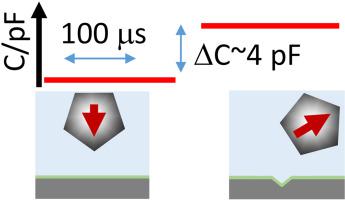Our official English website, www.x-mol.net, welcomes your feedback! (Note: you will need to create a separate account there.)
In-situ detection of single particle impact, erosion/corrosion and surface roughening
Wear ( IF 5 ) Pub Date : 2021-01-01 , DOI: 10.1016/j.wear.2020.203527 P.R. Birkin , R. Lear , L. Webster , L. Powell , H.L. Martin
Wear ( IF 5 ) Pub Date : 2021-01-01 , DOI: 10.1016/j.wear.2020.203527 P.R. Birkin , R. Lear , L. Webster , L. Powell , H.L. Martin

|
Abstract Particle impact is technologically important and can cause significant damage to a surface. Detecting the approach and impact of a particle would give key information on the process. High-speed imaging of this process gives information on a particle's velocity and movement but does not answer key questions relating to changes in electrochemical properties of a surface caused by the resultant damage on impact. Furthermore, it is difficult to apply in non-transparent media. To gain this key information, we have deployed a high-speed electrochemical impedance technique with the ability to determine the uncompensated resistance, Faradaic current and effective capacitance of an electrode. This technique has a time resolution of 1.25 μs Individual impacts of sand particles in a fluid jet (jet velocity ∼4–5 m s−1) are used to cause erosion/corrosion of an aluminium interface. Surface properties are shown to change after individual particle impacts, which is preceded by the electrochemical detection of the particle as it approached the solid/liquid interface. For the first time, the in-situ roughening of the electrode surface is reported for a single particle impact. A link between the effective mass loss of the electrode and the overall surface erosion is shown, with an equivalent roughening rate of 8.5 F g−1 as determined from the data. This study shows how individual sand particles, and the damage they cause to an interface, can be detected with high precision and new insight. This will improve our understanding of erosive environments.
中文翻译:

单粒子冲击、侵蚀/腐蚀和表面粗糙的原位检测
摘要 粒子撞击在技术上很重要,可能会对表面造成严重损坏。检测粒子的接近和影响将提供有关该过程的关键信息。这一过程的高速成像提供了关于粒子速度和运动的信息,但并没有回答与由撞击造成的损伤引起的表面电化学性质变化有关的关键问题。此外,难以应用于非透明介质。为了获得这一关键信息,我们采用了一种高速电化学阻抗技术,能够确定电极的未补偿电阻、法拉第电流和有效电容。该技术的时间分辨率为 1。25 μs 流体射流(射流速度 ∼4–5 m s-1)中沙粒的单个撞击被用来引起铝界面的侵蚀/腐蚀。表面特性在单个颗粒撞击后会发生变化,在此之前,当颗粒接近固/液界面时,会对其进行电化学检测。首次报道了单个粒子冲击的电极表面原位粗糙化。显示了电极的有效质量损失与整体表面侵蚀之间的联系,根据数据确定的等效粗糙化率为 8.5 F g-1。这项研究展示了如何以高精度和新的洞察力检测单个沙粒及其对界面造成的损害。这将提高我们对侵蚀性环境的理解。表面特性在单个颗粒撞击后会发生变化,在此之前,当颗粒接近固/液界面时,会对其进行电化学检测。首次报道了单个粒子冲击的电极表面原位粗糙化。显示了电极的有效质量损失与整体表面侵蚀之间的联系,根据数据确定的等效粗糙化率为 8.5 F g-1。这项研究展示了如何以高精度和新的洞察力检测单个沙粒及其对界面造成的损害。这将提高我们对侵蚀性环境的理解。表面特性在单个颗粒撞击后会发生变化,在此之前,当颗粒接近固/液界面时,会对其进行电化学检测。首次报道了单个粒子冲击的电极表面原位粗糙化。显示了电极的有效质量损失与整体表面侵蚀之间的联系,根据数据确定的等效粗糙化率为 8.5 F g-1。这项研究展示了如何以高精度和新的洞察力检测单个沙粒及其对界面造成的损害。这将提高我们对侵蚀性环境的理解。首次报道了单个粒子冲击的电极表面原位粗糙化。显示了电极的有效质量损失与整体表面侵蚀之间的联系,根据数据确定的等效粗糙化率为 8.5 F g-1。这项研究展示了如何以高精度和新的洞察力检测单个沙粒及其对界面造成的损害。这将提高我们对侵蚀性环境的理解。首次报道了单个粒子冲击的电极表面原位粗糙化。显示了电极的有效质量损失与整体表面侵蚀之间的联系,根据数据确定的等效粗糙化率为 8.5 F g-1。这项研究展示了如何以高精度和新的洞察力检测单个沙粒及其对界面造成的损害。这将提高我们对侵蚀性环境的理解。以及它们对接口造成的损坏,可以以高精度和新的洞察力进行检测。这将提高我们对侵蚀性环境的理解。以及它们对接口造成的损坏,可以以高精度和新的洞察力进行检测。这将提高我们对侵蚀性环境的理解。
更新日期:2021-01-01
中文翻译:

单粒子冲击、侵蚀/腐蚀和表面粗糙的原位检测
摘要 粒子撞击在技术上很重要,可能会对表面造成严重损坏。检测粒子的接近和影响将提供有关该过程的关键信息。这一过程的高速成像提供了关于粒子速度和运动的信息,但并没有回答与由撞击造成的损伤引起的表面电化学性质变化有关的关键问题。此外,难以应用于非透明介质。为了获得这一关键信息,我们采用了一种高速电化学阻抗技术,能够确定电极的未补偿电阻、法拉第电流和有效电容。该技术的时间分辨率为 1。25 μs 流体射流(射流速度 ∼4–5 m s-1)中沙粒的单个撞击被用来引起铝界面的侵蚀/腐蚀。表面特性在单个颗粒撞击后会发生变化,在此之前,当颗粒接近固/液界面时,会对其进行电化学检测。首次报道了单个粒子冲击的电极表面原位粗糙化。显示了电极的有效质量损失与整体表面侵蚀之间的联系,根据数据确定的等效粗糙化率为 8.5 F g-1。这项研究展示了如何以高精度和新的洞察力检测单个沙粒及其对界面造成的损害。这将提高我们对侵蚀性环境的理解。表面特性在单个颗粒撞击后会发生变化,在此之前,当颗粒接近固/液界面时,会对其进行电化学检测。首次报道了单个粒子冲击的电极表面原位粗糙化。显示了电极的有效质量损失与整体表面侵蚀之间的联系,根据数据确定的等效粗糙化率为 8.5 F g-1。这项研究展示了如何以高精度和新的洞察力检测单个沙粒及其对界面造成的损害。这将提高我们对侵蚀性环境的理解。表面特性在单个颗粒撞击后会发生变化,在此之前,当颗粒接近固/液界面时,会对其进行电化学检测。首次报道了单个粒子冲击的电极表面原位粗糙化。显示了电极的有效质量损失与整体表面侵蚀之间的联系,根据数据确定的等效粗糙化率为 8.5 F g-1。这项研究展示了如何以高精度和新的洞察力检测单个沙粒及其对界面造成的损害。这将提高我们对侵蚀性环境的理解。首次报道了单个粒子冲击的电极表面原位粗糙化。显示了电极的有效质量损失与整体表面侵蚀之间的联系,根据数据确定的等效粗糙化率为 8.5 F g-1。这项研究展示了如何以高精度和新的洞察力检测单个沙粒及其对界面造成的损害。这将提高我们对侵蚀性环境的理解。首次报道了单个粒子冲击的电极表面原位粗糙化。显示了电极的有效质量损失与整体表面侵蚀之间的联系,根据数据确定的等效粗糙化率为 8.5 F g-1。这项研究展示了如何以高精度和新的洞察力检测单个沙粒及其对界面造成的损害。这将提高我们对侵蚀性环境的理解。以及它们对接口造成的损坏,可以以高精度和新的洞察力进行检测。这将提高我们对侵蚀性环境的理解。以及它们对接口造成的损坏,可以以高精度和新的洞察力进行检测。这将提高我们对侵蚀性环境的理解。


























 京公网安备 11010802027423号
京公网安备 11010802027423号